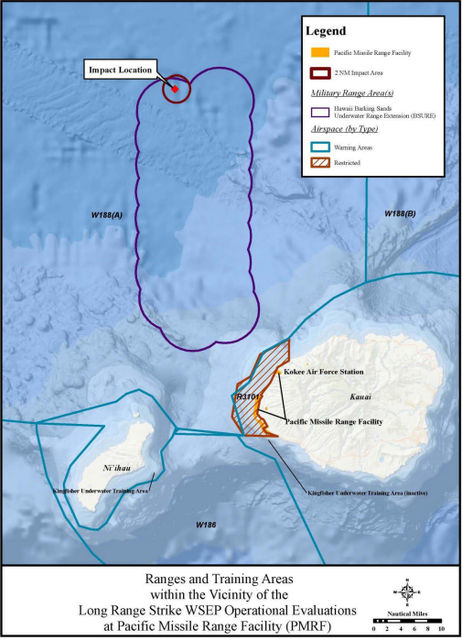KEKAHA — The Air Force wants to bring its weapons testing program back to the Pacific Missile Range Facility and a public comment period on the program closes Monday. The 86 Fighter Weapons Squadron (86 FWS) wants to spend the
KEKAHA — The Air Force wants to bring its weapons testing program back to the Pacific Missile Range Facility and a public comment period on the program closes Monday.
The 86 Fighter Weapons Squadron (86 FWS) wants to spend the next five years training with the Long Range Strike Weapon Systems Evaluation Program (WSEP) in PMRF’s Barking Sands Underwater Range Extension area.
Using mainly bombers and fighter aircraft, the missions will include detonations of a variety of missiles and other weapons above the water, at the water surface and slightly below the water surface.
Live and inert bombs and missiles may be used, depending on the mission.
All missions will be conducted during daylight hours, primarily during the summer, beginning in September.
The impact area is located roughly 44 nautical miles offshore of Kauai in a water depth of about 15,240 feet.
Noise levels shouldn’t rise above the usual sounds of Navy operations because of the missions, the 53rd Wing Public Affairs Office told TGI on Friday.
In a December 86 FWS request for a National Marine Fisheries Service (NMFS) incidental marine mammal take letter of authorization (LOA), further possible interruptions of life on the island are outlined.
These types of training missions have been conducted at PMRF before, and the request for an LOA is part of the process. Also part of the process is allowing public comment on that request.
The deadline to submit comments on this incidental take LOA request is Monday.
Impacts to the public include the possibility of closing PMRF to the public for a maximum of four hours per mission day and a potential of using small watercraft at Port Allen to keep near-shore areas clear of tour boats during some missions.
Underwater, the air-to-surface missions could cause acoustic and pressure-related problems for whales, dolphins and other marine mammals in the area.
Some whale activists on Kauai are concerned about the impact training sessions have on the cetaceans that live and travel in the waters around Hawaii.
Once federal permission is granted, it’s hard to stop the wheels from turning, activists say.
“The only way to stop them from getting permits to kill whales and dolphins is to sue them,” said Gordon LaBedz of Kauai’s whale education group Kohola Leo. “When we do, we usually win, but the conservation community only has so much money for attorneys.”
But some say it’s a complicated subject because information on the effects of weapons testing on cetaceans and other marine mammals is scarce and difficult to interpret.
“We don’t even know the intensity of the sound that reaches an animal caused by a missile launch,” said Whitlow Au, chief scientist of the Marine Mammal Research Program at the Hawaii Institute of Marine Biology at the University of Hawaii.
If a whale in the area dives when a missile is being launched, that could be interpreted as a reaction to the launch, or it could just be natural behavior, he explained.
“If we’re lucky enough, we’ll be able to have a tag on a whale that is happening to experience a launch and then we can get an idea of what kind of sound it might have received. Then we can interpret its behavior,” Au said.
UH study proposed
For the past five years, Au and his students have been focusing on humpback whales and how they use sound to navigate and communicate.
They’ve also applied with NMFS for a five-year permit to investigate population dynamics, with specific focus on the acoustic environment and the effects of noise behavior on whales and dolphins.
“It’s a formality, but you’ve got to have (the permit) if you’re going to research,” Au said.
Public comments can be submitted to NMFS until Feb. 16 on that application.
“I have a student that’s been putting acoustic tags on humpback whales — mother and calf pairs — and we want to learn what kind of sounds the calf and mother emit, what the levels of the sounds are, and their characteristics,” Au said.
The goal is to discover how humpback whales learn and use sounds, particularly within the mother-calf relationship.
While much research still needs to be conducted on the relationship between underwater sounds and the wellness of the whales, Au said he’s not convinced weapons testing negatively impacts marine mammals.
“A launch sound would be, I think, not very intense because the whale might be a mile or half a mile offshore,” Au said. “That’s about as close as they’ll come to the PMRF launch site and the level of sounds that reach the whale might be relatively low.”
The training exercises are imperative to the nation’s safety, Au said, and the highest priority should be finding ways to train troops without harming sea life.
“These groups of people have to learn how to work together in a collaborative-type relationship,” he said.



